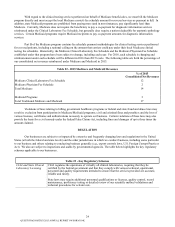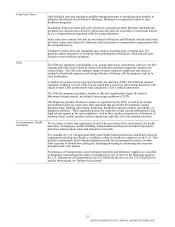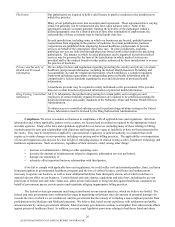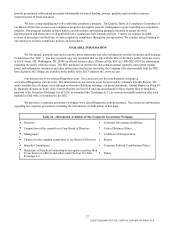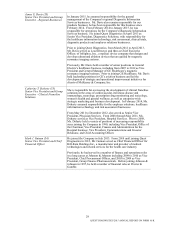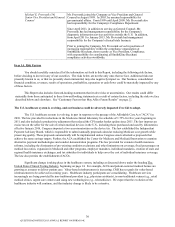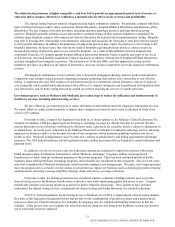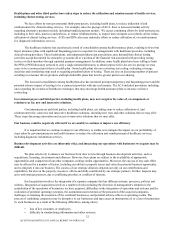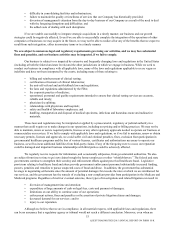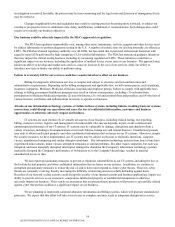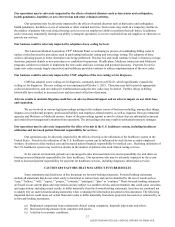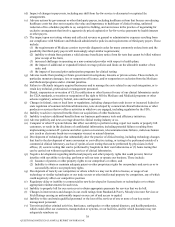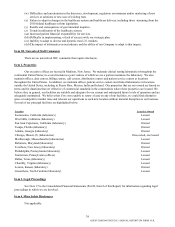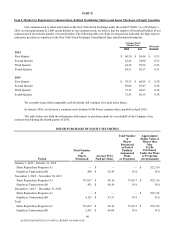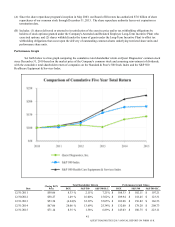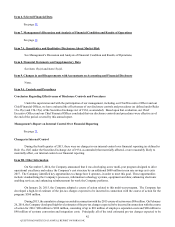Quest Diagnostics 2015 Annual Report Download - page 38
Download and view the complete annual report
Please find page 38 of the 2015 Quest Diagnostics annual report below. You can navigate through the pages in the report by either clicking on the pages listed below, or by using the keyword search tool below to find specific information within the annual report.34
investigation is resolved favorably, the process may be time-consuming and the legal costs and diversion of management focus
may be extensive.
Changes in applicable laws and regulations may result in existing practices becoming more restricted, or subject our
existing or proposed services to additional costs, delay, modification, withdrawal or reconsideration. Such changes also could
require us to modify our business objectives.
Our business could be adversely impacted by the FDA's approach to regulation.
The FDA has regulatory responsibility over, among other areas, instruments, test kits, reagents and other devices used
by clinical laboratories to perform diagnostic testing in the U.S. A number of esoteric tests we develop internally are offered as
LDTs. The FDA has claimed regulatory authority over all LDTs, but has stated that it exercised enforcement discretion with
regard to most LDTs performed by high complexity CLIA-certified laboratories. The FDA has announced guidance initiatives
that may impact the clinical testing business, including by increasing regulation of LDTs. These initiatives could have a
significant impact on our business, including the application of medical device excise taxes to our business. The approach may
hinder our ability to develop and market new services, cause an increase in the cost of our services, delay our ability to
introduce new tests or hinder our ability to perform testing.
Failure to accurately bill for our services could have a material adverse effect on our business.
Billing for diagnostic information services is complex and subject to extensive and non-uniform rules and
administrative requirements. Depending on the billing arrangement and applicable law, we bill various payers, such as patients,
insurance companies, Medicare, Medicaid, clinicians, hospitals and employer groups. Failure to comply with applicable laws
relating to billing government healthcare programs may result in various consequences, including: (1) exclusion from
participation in Medicare/Medicaid programs; (2) asset forfeitures; (3) civil and criminal fines and penalties; and (4) the loss of
various licenses, certificates and authorizations necessary to operate our business.
Attacks on our information technology systems, or failure in these systems, including failures resulting from our systems
conversions, could disrupt our operations and cause the loss of confidential information, customers and business
opportunities or otherwise adversely impact our business.
IT systems are used extensively in virtually all aspects of our business, including clinical testing, test reporting,
billing, customer service, logistics and management of medical data. Our success depends, in part, on the continued and
uninterrupted performance of our IT systems. IT systems may be vulnerable to damage, disruptions and shutdown from a
variety of sources, including telecommunications or network failures, human acts and natural disasters. Unauthorized persons
may seek to obtain intellectual property and other confidential information that we house on our IT systems. Moreover, despite
the security measures we have implemented, our IT systems may be subject to physical or electronic intrusions, computer
viruses, unauthorized tampering and similar disruptive problems. Our information technology systems from time to time have
experienced minor attacks, minor viruses, attempted intrusions or similar problems, like other major companies, but each was
mitigated, and none materially disrupted, interrupted, damaged or shutdown the Company's information technology systems,
materially disrupted the Company's performance of its business or, to the Company's knowledge, resulted in material
unauthorized access to data.
We have taken precautionary measures to prevent or minimize vulnerabilities in our IT systems, including the loss or
theft of intellectual property and other confidential information that we house on our systems. In addition, we continue to
strengthen precautionary measures to reduce the risk of, and to detect and respond to, future cyber threats. However, cyber
threats are constantly evolving, thereby increasing the difficulty of detecting and successfully defending against them.
Breaches of our network or data security could disrupt the security of our internal systems and business applications, impair our
ability to provide services to our customers, compromise intellectual property or confidential information or otherwise
adversely impact our business. There can be no assurances that our precautionary measures will prevent or successfully defend
against cyber threats that could have a significant impact on our business.
We are planning to implement common laboratory information and billing systems, which will promote standardized
processes. We expect that this effort will take several years to complete and may result in temporary disruptions in service.
QUEST DIAGNOSTICS 2015 ANNUAL REPORT ON FORM 10-K


